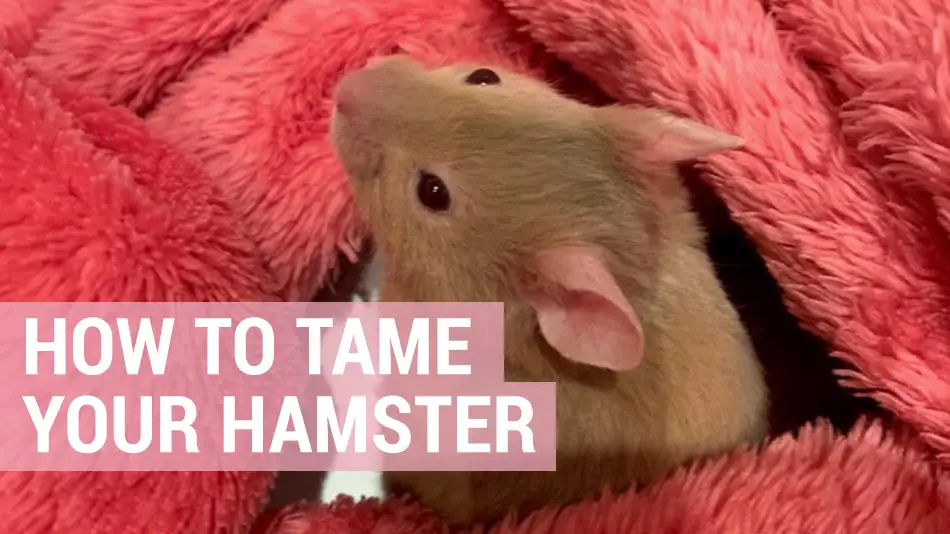Taming your hamster
Hamsters may not always enjoy the company of their own kind but believe it or not they are actually very social animals who enjoy spending time away from their cage and being handled by their owners. Taming and holding your hamster are great ways to bond and play and can also provide good opportunities to spot any potential health issues. But remember, your hamster may never have been handled before, so you need to be patient before you leap straight in.
Hamsters are pretty obliging animals who often enjoy being held as much as we enjoy doing it. Most hamsters can be tamed quickly with regular, gentle handling, but in order to build up complete trust, there are certain processes I would recommend following when taming your hamster. This will minimise stress and anxiety and decrease the risk of fingers being bitten.
Persistence (and a fair amount of bribery) will pay off if you follow these basic steps for taming your hamster, and within a matter of weeks (if not months), your anxious, furry ninja will end up being one cuddly, happy hamster.
Taming Step 1 – how to help your hamster settle in
Take a moment to place yourself in your hamsters’ paws. Just imagine if you had suddenly been whisked away from the bright lights and familiar smells of the pet shop, only to find yourself plunged into a new cage, with unfamiliar eyes staring at you. It would be pretty scary wouldn’t it? Well this is the scenario that you own pet hamster will have gone through when you first collect them. So be patient with them, give them time to settle in, adjust and explore their new environment.
As a family who has recently been through the taming process, I know that it is almost impossible to stop little hands from wanting to open the cage for a quick cuddle with their new best friend. But trust me, the longer you can give your hamster to relax the quicker the taming process will be.
I would suggest giving your hamster at least 2-3 days (if not longer) to acquaint themselves with their new surroundings. Talk to them regularly during this time so that they get to know your voice, and check to see that they are happy to do normal hamster things like eat, drink and play in your presence.
As tempting as these cute fur balls may be, do not rush this first step to taming your hamster as it is important that it starts to trust you from the outset.
Taming Step 2 – how to offer your hamster treats
Once your hamster starts to show signs that they are curious in you i.e./coming up to the bars, you can start to coax them further by offering them a treat. You must, however, wait until they are fully awake, and never encroach on their personal space such as their nest or bedding area.
We had a situation where our daughter attempted to wake our hamster Oscar up, by forcefully shoving some food in his face whilst he was still blissfully in the land of slumber. Let’s just say it didn’t end well for either party who both received the shock of their lives. So remember, always take things at your hamster’s pace.
To start with, try feeding them extra treats through the bars of the cage and once they are content to take them from your fingers, you can try placing your hand calmly inside – offering further delicacies off the palm of your hand. Make sure your hands are clean and try to keep them as still as possible, as any sudden movement may scare them. Don’t worry if you hamster appears a little reluctant at first, if you continue the process little and often, they will soon get used to your scent. It is also a good idea to mix up the snack you are offering as it not only encourages them to try new foods but if you pick something, they are not interested in they will be less inclined to venture out.
Another good way to building up a bond with your hamster is to place some toilet paper that you have handled in their cage for them to nest in.
Once your hamster is happy to hop on and off your hand you are ready to move on to step 3.

Taming Step 3 – how to play with your hamster
It is really important that you find a safe and secure place to hold, play and bond with your hamster outside of their cage. This could be in a large box, play pen or as we prefer, the bath. Trust me, it’s the only time my children will willing jump in it!
Make sure the area is comfortable for both yourself to sit in and that it offers a soft-landing place should your hamster decide to jump around. Carefully coerce your hamster into a container or cup by using a tried and tested treat. By this point your hamster should be inquisitive enough to hop straight in.
Carrying them carefully take them to your secure play place. Once inside the bath set them down gentle and under their own steam let them run around, sniff you, climb on you and generally get to know you. Take some tubes and hamster toys for them to scamper, climb and nibble on.
Taming Step 4 – how to hold your hamster
The next step is to get your hamster used to being held. Some people find this scary as untamed hamsters are often skittish. Therefore, if you are anxious then I would suggest wearing gloves at first to take away any fear of being bitten.
Once they are familiar with the secure play area, I would suggest slowly placing your hands in your hamsters’ path and letting it run across them whilst on the ground. If they are happy to do this a number of times then wait from them to climb on and gently, whilst supporting their back and bottom, encourage your hamster to move from one hand to the other. Remember hamsters can move quickly so keep them held low at first, supporting them all the while. If they seem at ease with being held, then you can try stroking them whilst in the palm of your hand, with a small brush or finger.
Taming Step 5 – how to pick up your hamster
Once your hamster is happy to be held, the final part to taming them it to get them comfortable with being calmly picked up.
It is really important that you pick your hamster up without panicking them, so never lunge or grab at them. Hamsters are notorious for having bad eyesight so therefore any fast movements are likely to make them jumpy.
When they show signs of trust and are happily running across your hands, start to lift them higher in the air before placing them back down so that they understand that they won’t come to any harm. You should support their bottom in a cupping motion, so that they feel secure. If they start to wriggle their feet or squeak, put them back down immediately. Do not grip them too tightly when they move or squeeze them in an attempt to make them stop.
Repeat this process regularly and for longer periods of times and eventually they will get so used to being held that they will sit contently in your hand and revel in being cuddled.
Related Questions:
How long does it take to tame a hamster?
Each hamster is totally unique. Some may want to immediately bond with you, whereas others may take a number of weeks or even months to tame. Syrian hamsters, in the main, tend to be more receptive to taming, whether other species such as Roborovski’s take more time as they are small, skittish and shy. My advice is to simply be patient.
Do hamsters enjoy being petted?
Syrian hamsters are solitary pets, so thrive on human interaction. This includes affection such as petting and cuddling, and they will often show their appreciation by snuggling or falling asleep whilst being held. Most species can identify their owners’ scent and will be at their most content when spending time with them.
Why do hamsters bite?
Hamsters tend to bite out of fear, stress and anxiety. If your hamster is unused to being handled at all, then they may nip you because they are scared. They also need their sleep, and do not take kindly to being disturbed or startled. Finally, if you fail to wash your hands before handling your hamster then there is a chance that it may confuse your finger for a tasty treat. The more trust you can build with your hamster, the happier you both will be.
Good luck!


